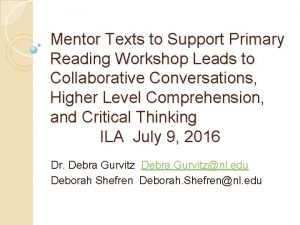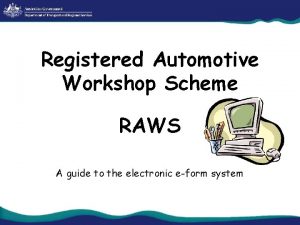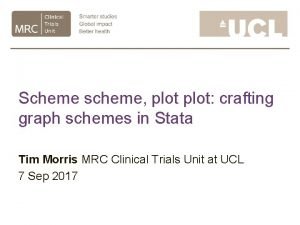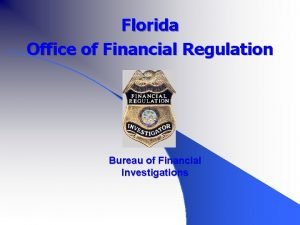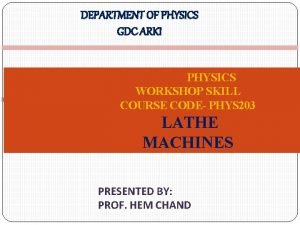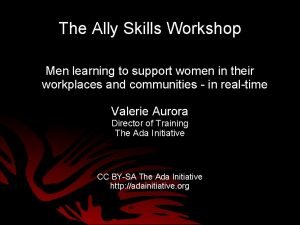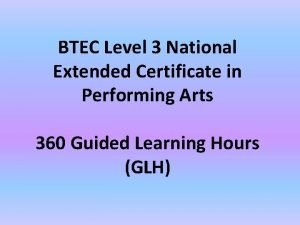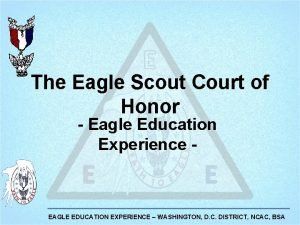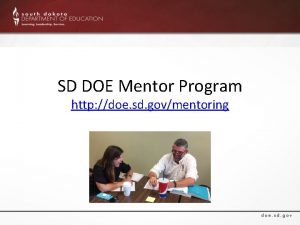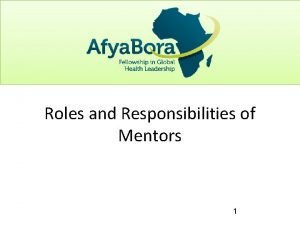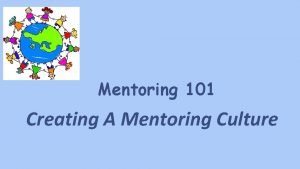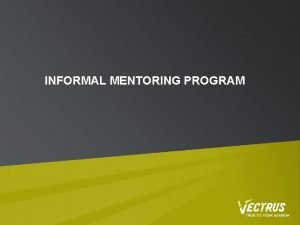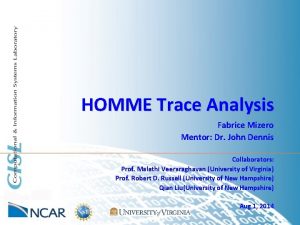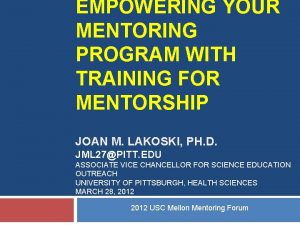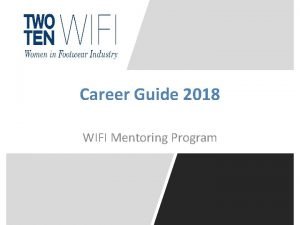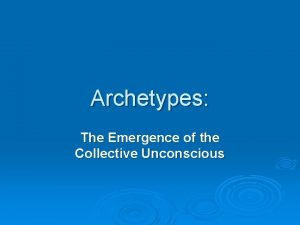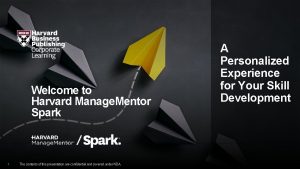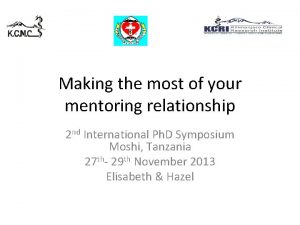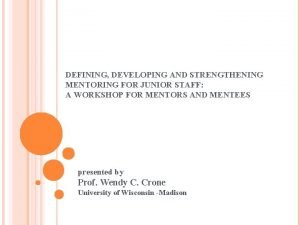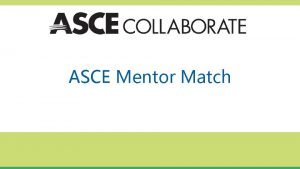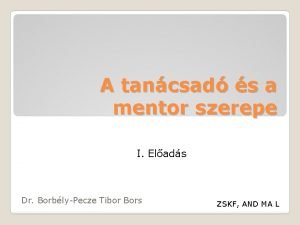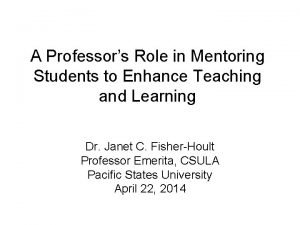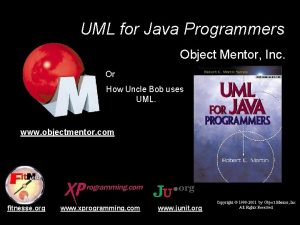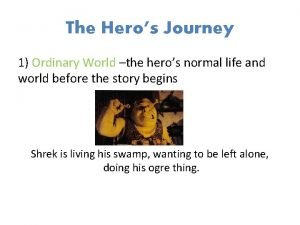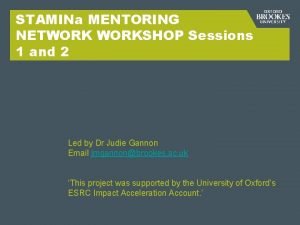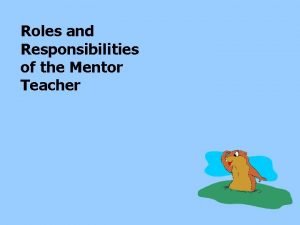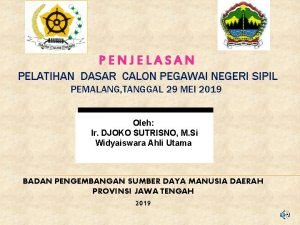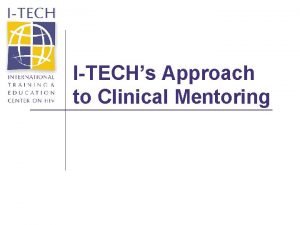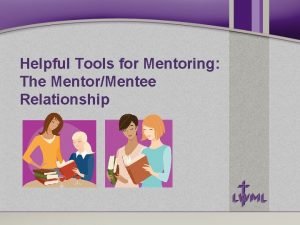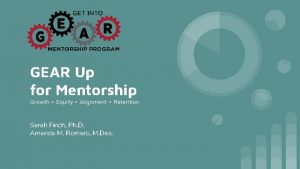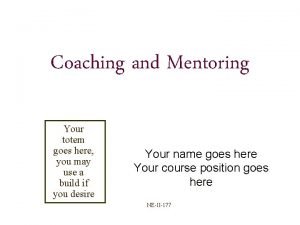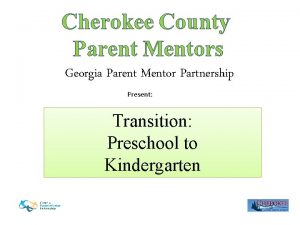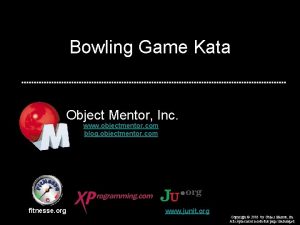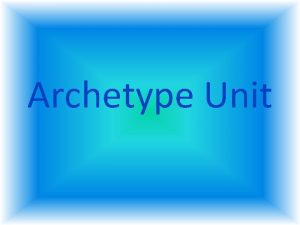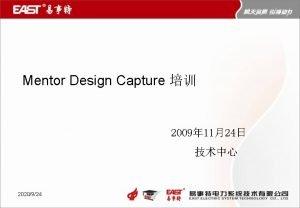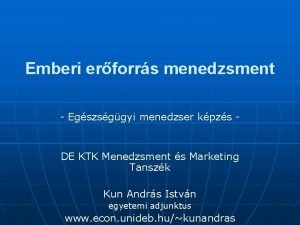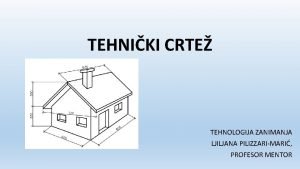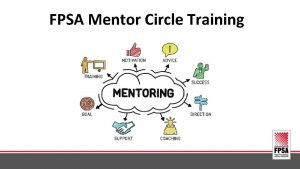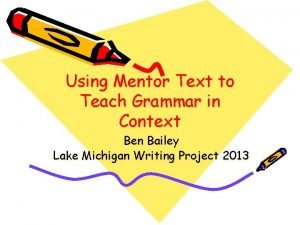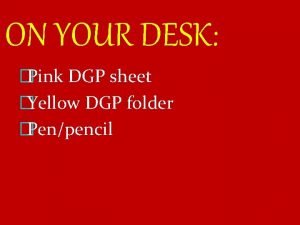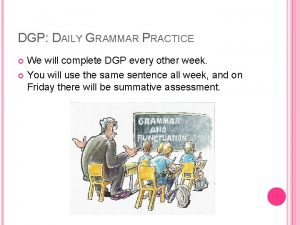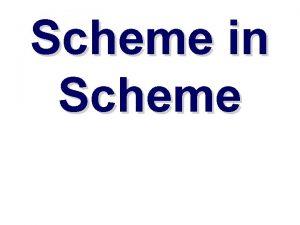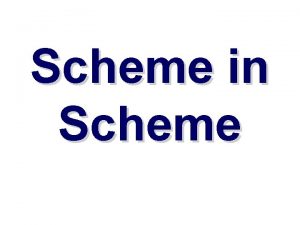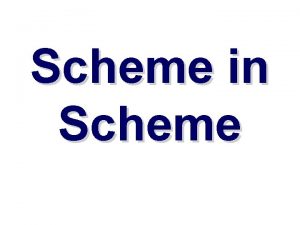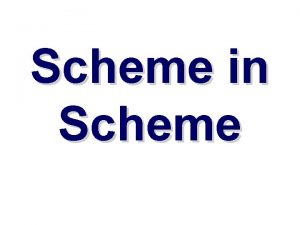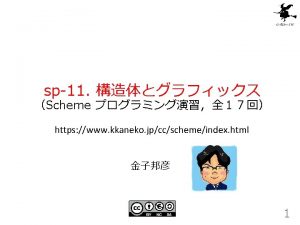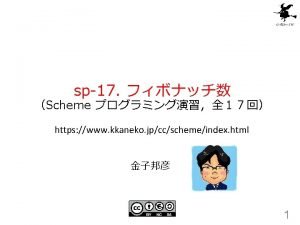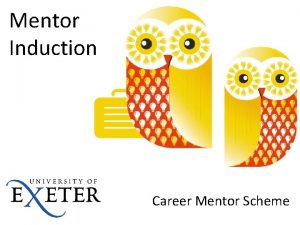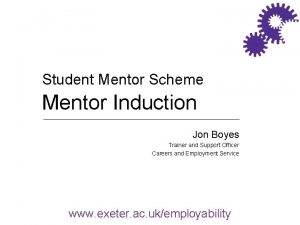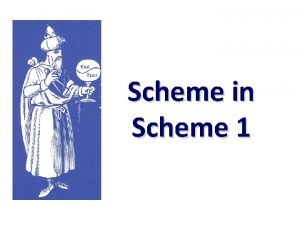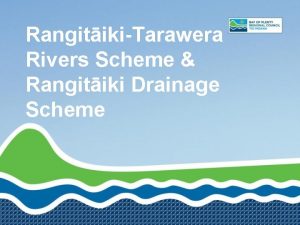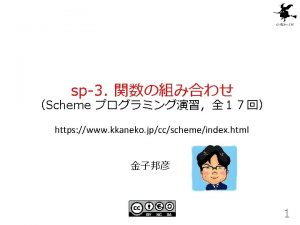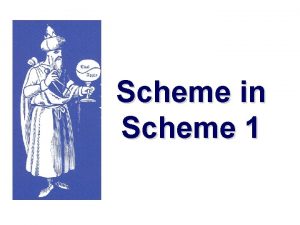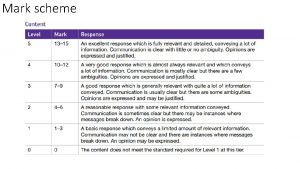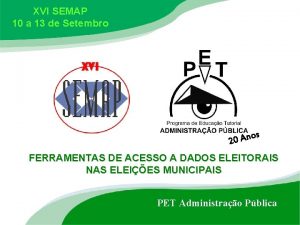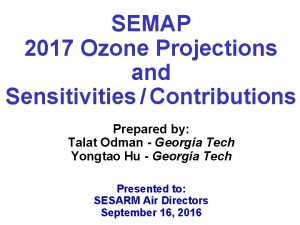DGP Skills Group SEMAP SEMAP Scheme Mentor Workshop
































































- Slides: 64

DGP Skills Group SEMAP – SEMAP Scheme Mentor Workshop 12 th Feb 2016 v 1

The Need for Good Systems Engineering ……. Systems Engineers focus on solving some of the most complex engineering challenges. They do this by collecting and organising all the information needed to understand the whole problem, exploring it from all angles, and then finding the most appropriate solution. The Requirements specified and agreed by all parties were: • Build a moat • 3 m Wide; 2 m Deep • Filled with water But, the product was unlikely to meet the users needs…… Page 2

Today • Aim of Today - Mentor workstream lead to give update brief on mentoring - Cross-brief good practice - SAS / Metskill to brief their requirements as Lead Provider - Take stock of scheme launch and feedback from opening session at Cranfield - Raise / solve issues regarding the scheme start up and future • Andy Sheath Page 3

Agenda 1030 Introduction Charles Critchett 1100 SEMTA (Metskill) brief Neil Goodliffe/Jon Mitchell 1130 Mentor pack brief Anish Kharkar 1230 Lunch 1330 Break-out 1430 Cross-brief 1515 Recap / Actions and Close 1530 Close Charles Page 4

Introduction Charles Critchett (Chair) Steve Addiscott (Assessment Plan) Phil Cutcher (DSC + SEMTA and Funding lead) Emma Sparks, Tony Thornburn and Tim Ferris (Cranfield University – Academic Lead) Working Group Lead Assessor Mentors Training Manager Atkins Charles / Steve Peter Bruce Kevan Boll David Blogg BAE Systems Alan Harding Dawn Rayson Alan Harding Andrew Smith, Mark Agnew, Philip Wilson, Richard Bennett Dawn Rayson Cobham Gerry Bishop Christopher Nunn DE&S Anish Kharkar Duncan Kemp Philip Savvides Sam Williams, Jack Kebbell Jon Brooking Dstl David Oxenham Ivan Mactaggart Bob Madahar Gordon Pattison Simon Swales Selena Wright MBDA Phil Threlfall Paul Hacker? Cathy Strachan David Venn Ian Dodd Douglas Craig Jan Pietrzkiewicz Jason Hay Neill Goodliffe SEMTA Qineti. Q Diane Wilford and Rebecca Rhodes BIS and Skills Funding Agency Raytheon David Venn Gerry Bishop Phil Davenport Christopher Jackson Ben Lockwood Rolls-Royce Richard Beasley Tim Harding Selex ES Allan Colquhoun Jane Phelps Thales Les Oliver Laura Shrieves Ian Alston Jim Henderson Thomas Riley Jason Simeon Page 5

SEMAP Overview The Systems Engineering Master's Apprenticeship Programme (SEMAP) is a 3 -5 year programme of blended vocational and academic learning at Master's level that will develop a rounded systems engineer at INCOSE practitioner level who should also be able to apply for a CEng. Page 6

Numbers Company Jan 2016 intake Atkins 2 BAE Systems 7 Cobham 0 General Dynamics 0 MBDA 1 MOD DE&S/Mo. D 16 MOD Dstl 2 Qineti. Q 10 Raytheon 2 Rolls-Royce 1 Selex ES 8 Thales 3 52 Page 7

The Journey – as at Sept 2015 • • Employer group comprised 20 parties from employers, academia, professional bodies - in partnership with BIS Skills Funding Agency. Employers: Atkins, Altran, BAES, Cobham, General Dynamics, Marshall, MBDA, Mo. D DE&S, Dstl, Qineti. Q, Raytheon, Rolls-Royce, Selex ES and Thales Universities: Cranfield University, Bristol University, Loughborough University, UCL Professional bodies: INCOSE 1, SEMTA, Royal Academy of Engineering, IET September 2014 Employer group formed With Atkins lead Chair: Allan Cook CBE March 2015 Standard approved 1. International Council on Systems Engineering January 2016 First apprentices start August 2015 Assessment Plan Approved & SAS Metskill Engaged Page 8

The Journey – Feb 2016 looking forward • • Cohort 1 (52): Atkins, BAES, MBDA, Mo. D DE&S, Dstl, Qineti. Q, Raytheon, Rolls-Royce, Selex ES and Thales. Lead Provider. Contacts in place with SEMTA Apprenticeship Services (Metskills). Future Ambition. Publicise SEMAP to additional companies, SMEs and others in parallel sectors. Universities. Setup collaboration agreements and agree shared modules. Assess if another University would like to be a lead academic provider. Governance. Establish long term SEMAP governance – future of working group. Cohort 2 starts. Timetable? Funding? Candidates Assessment Organisation. Identify and contract with an Assessment Organisation February 2016 Lead Provider, SAS Metskills Contracted* January 2016 Cohort 1 start April 2016 University Arrangements March 2016 Future Ambition Sept 2016 Cohort 2 start June 2016 Governance Stood up Nov 2016 Assessment organisation on contract Page 9

Agenda 1030 Introduction Charles Critchett 1100 SEMTA (Metskill) brief Neil Goodliffe/Jon Mitchell 1130 Mentor pack brief Anish Kharkar 1230 Lunch 1330 Break-out 1430 Cross-brief 1515 Recap / Actions and Close 1530 Close Charles Page 17

The Role of Semta Apprenticeship Service (SAS) 12 February 2016 Neill Goodliffe & Jon Mitchell

Presentation Outcomes • • Introductions and background The role of SAS within the process Length of stay and timely success Purpose of the learner review and driver Our external stakeholders and responsibilities Review cycle and content Behaviours within framework

Introductions & Background • Neill Goodliffe – SEMAP Project Manager • Jon Mitchell – Quality Manager Semta Apprenticeship Service

The role of SAS within the process • Sector specialists within Employer Led Apprenticeships • Funding conduit from Skills Funding Agency • Managing Agent – audit compliance

Length of stay on programme • Start date / end date • Achievement and timely success • Provider quality measures

External stakeholders • Skills Funding Agency (SFA) • Ofsted – Standards of education & training • Awarding Organisations (AO)

Review cycle • Regular review – monitor and drive timely success – SMART targets – Individual framework components, overall success – Visibility and intervention • Employer engagement

Behaviours within framework • Competence qualifications (binary) • Component within Employer led apprenticeships – Personal development – Measurable improvement – Impact on business from any interventions (Kirkpatrick, et al)

Summary • • • Overall role of SAS Length of stay on programme Purpose of reviews and management of learning External stakeholders and responsibilities Review cycle and content Behaviours within framework

Agenda 1030 Introduction Charles Critchett 1100 SEMTA (Metskill) brief Neil Goodliffe/Jon Mitchell 1130 Mentor pack brief Anish Kharkar 1230 Lunch 1330 Break-out 1430 Cross-brief 1515 Recap / Actions and Close 1530 Close Charles Page 27

DGP SEMAP Mentor Workshop 18 th August 2015 Anish Kharkar Presentation Title & Date

Clarification of role – Mentor vs Assessors Mentor • • • Coaches and guides the development of the apprentice Helps them understand the competency framework Helps them develop the DAP and Logbook Helps set up the vocational tasks Develop good working relationship with the lead assessor especially as the scheme matures A typical mentor would be: • Charted Engineer - Systems Engineers • Should have a good understanding the SEMAP scheme Each apprentice will have one mentor Each mentor probably should have no more than two mentees (TBD) Presentation Title & Date 29

Clarification of role – Mentor vs Assessor • • Capable of assessing if apprentice has met the competency standard Carry out testing of the apprentices skills and competencies against the Assessment Plan Small number of assessors who would be more senior / experienced than mentors Assessors are the companies owner of the standard (internal owner) An assessor can be a mentor, but not all mentors can be assessors An assessor would be someone who can answer the questions: “Will the company hire the apprentice? ” “Has the apprentice developed to be a trusted / competent Systems Engineer? ” “Would I trust the apprentices’ judgement on safety critical SE tasks? ” Presentation Title & Date 30

Overview - What makes up a good mentor • • What should they do and not do Good understanding of the relevant competency standard Good understanding of the SEMAP scheme Understanding of SE / SE Practitioner level – How many competencies should the mentor have and at what level? – More experienced to mentee in terms of competencies • Good “non-directive” mentor – Undergone mentor training? Has mentoring experience? • Understands HR / Legal issues – Equality and Diversity trained • • Has rapport with apprentice – Mutual respect Wider business understanding and networking – – Understand the business and it’s priorities Aware of possibilities / opportunities within the business Has existing network and will use it Willing to be part of the mentor network Presentation Title & Date 31

Route to Chartered Engineer (CEng) • • • After successful completion of the scheme, the apprentice can apply for Chartered Engineer (CEng) professional registration with any institution of their choice Professional registration advice is not part of the formal scheme The evidence gathered during the scheme can be used to support their CEng application Role of Mentor / PRA: – The SEMAP mentor will guide the apprentice until the End Point Assessment – After completion of the scheme, the Professional Registration Advisor (PRA) will guide and advice the apprentice in regards to CEng professional registration – The SEMAP mentor and the PRA can be the same person Useful links for further information: International Council on Systems Engineering (INCOSE) - Recommended http: //incoseonline. org. uk/Normal_Files/Professional_Development/Becoming_a_CEng_IEng. aspx? Cat. I D=Professional_Development Institute of Engineering and Technology (IET) http: //www. theiet. org/membership/profreg/ceng/ Institute of Mechanical Engineers (IMech. E) http: //www. imeche. org/membership-registration/How-to-apply/member/CEng-process-andforms Presentation Title & Date

Mentor Handbook The Mentor Handbook (slides) gives information and guidance on: – Overview of the mentors role – What the mentor needs to do in the SEMAP scheme – What to expect from apprentices – Hints & Tips on good practices for mentors – Templates Presentation Title & Date 33

Outline of Handbook / Table of Contents • • • Overview of Scheme Process / Timelines Initial Meeting Initial Planning Meetings Vocational Tasks Academic Courses Pre-Assessment Review Assessment Preparation Dealing with Failing Apprentices Learning & Sharing Appendices – Templates for logbooks / other documents Presentation Title & Date 34

Overview of Scheme • • • History and Background of SEMAP Purpose – What the scheme is aiming to produce Structure / Approach – – – • Key roles – – • • • Academic Vocational End Point Assessment Apprentice Mentor – Academic & Vocational Scheme Lead Assessor Requirements for successful completion Timelines Effort to be put in by mentor – – How many times should the mentor / mentee meet? How involved should the mentor be? Presentation Title & Date 35

Mentor / Mentee engagement sequence Registration 1 st two week Academic course 1 Initial Meeting Initial Planning Meeting – Development Action Plan (DAP) Initial Planning Meeting – Self Assessment (SA) Academic Vocational Agree Learning Objectives (LO) Agree Vocational experience objectives Start / End Academic modules Meetings Vocational tasks Do academic modules Do SE job / tasks Review LOs Write Logbook Review task Decision points Update DAP N Y Any planned modules (MSc timetable)? N Review Standard met? Y End Point Assessment 2 Presentation Title & Date 1 – The 1 st two week academic course may be skipped if the apprentice has a certain amount of experience (TBD between mentor / mentee). In this case, go directly to planning meeting. 2 - The apprentice has to complete the academic degree (Pg. Dip) in order to reach the End Point Assessment stage. 36

Timeline of meetings between Mentor & Mentee Start of scheme Main stage Sept / Jan Repeat main stage till end of scheme Academic module Meetings Registration and Matching completed Decision point Initial Meeting Start / End 1 st two week Academic modules Initial Planning meetings – SA and DAP Job objectives identified and SE job set up 1 SE job / tasks At the end, review SE job / task. Update DAP and Logbook … Regular meetings to review progress Competencies met? (NO) Academic Modules planned? 2 (NO) Competencies met? (YES) END POINT ASSESSMENT Academic Modules planned? If no Academic Modules planned, continue with SE job Agree learning objectives (LO) Academic modules Prep Assignments ≈ 5 weeks 1 - 2 weeks ≈ 5 weeks Prep Exams Review LO. Update DAP. 1 Should match / complement the academic modules and the selected competencies Plan should be prepared for next 1 year Presentation Title & Date 2 The apprentice has to complete the academic degree (Pg. Dip) in order to reach the End Point Assessment stage 37

Initial Meeting Purpose • • • Introduction Explanation of scheme and competency framework to apprentice Agree on how you are going to work Agree next few meetings Agree if the mentor/mentee fit is right (functionally) Initiate the development of SA and DAP by mentee Role of Apprentice • • Arrange meeting Perform/take most of the actions/outcomes of initial meeting Capture actions and write up meeting report Come prepared: – The apprentice can be given an introductory booklet to prepare for the initial meeting – Have a rough idea of what they want to achieve – Why did they agree to do the scheme? Presentation Title & Date 38

Initial Meeting Role of Mentor • • • Explain scheme to apprentice 1 Brief outline of your career Introduce / explain the competency framework and the standard (how many competencies should be achieved) Challenge their assumption about the scheme (if required) Check that apprentice is taking actions during meeting Share examples of good / bad practices with mentor network & scheme lead Hints & Tips • • • The Initial Meeting should be held BEFORE the first 2 weeks academic training at Cranfield (or any other participating university) Discussing the competency framework will help the apprentice prepare the draft Self Assessment and Development Action Plan The view of focus / most desired competencies of the company should be discussed in the initial meeting (these will influence the selection of competencies) The apprentice owns their development. The mentor should avoid owning any actions related to this during the Initial Meeting Mentor’s role is to enable, support, reflect and challenge 1 The mentee might know more about the scheme since he would have read about it recently, Presentation Title & Date prepared a business case for his inclusion, etc… 39

Initial Planning Meetings - SA and DAP Purpose • Agree Self Assessment against competencies (UK Spec and INCOSE) • Agree optional academic modules • Agree the competencies to pursue • Agree high level Development Action Plan • Agree first role / task / assignment Role of Apprentice • Prepare and bring draft Self Assessment • Prepare and bring draft Development Action Plan and details of next SE task • Reflect between Self Assessment and Development Action Planning sessions Presentation Title & Date 40

Initial Planning Meetings – SA and DAP Role of Mentor • • Review and challenge Self Assessment Review and challenge Development Action Plan and next task Advice and help find appropriate SE task Help the mentee identify the implications of their DAP (move jobs within company to get experience, etc. . ) Hints & Tips • This meeting can be split in 2 parts with a gap in between: – One meeting for Self Assessment – Follow up meeting to discuss Development Action Plan • The first Initial Planning Meeting should be done immediately after the first 2 week academic training During the course of the scheme, the plan in terms of development objectives should be defined 3 year (TBD) in advance – This is in order to look as far in advance as possible to allow for realistic planning of posting/tasking opportunities Specific tasks / jobs would not expect to be agreed more than 3 -6 months ahead The plan needs to be flexible – it will change! These meetings are part of an iterative process, with reflection, that aims to define and maintain the apprentice’s competency profile The lead assessors may wish to approve the DAP • • • Presentation Title & Date 41

Vocational Tasks Purpose of SE job / task • To gain practical experience to match their plan • To lead / perform specific SE tasks to demonstrate competence • To collect evidence of & reflect on development of SE competencies Role of Apprentice • Identify competencies they hope to develop and what evidence will be required • Ensure task objectives are suitable • Raise any issues / concerns early • Undertake SE task • Write up portfolio / evidence in STARLE format • Review and update Development Action Plan • Give feedback to mentor on SE task Presentation Title & Date 42

Vocational Tasks Role of Mentor • Confirm the development objectives can be met via the available vocational • tasks If not, action might be taken: – Upwards reporting – Resolve issue with the mentee’s line manager • • • Review plan and objectives Help resolve issues / concerns quickly Review portfolio / evidence & provide feedback: – Were competencies met? – Is the portfolio good enough? – Is the evidence good enough? • • Review updated Development Action Plan Inform scheme lead of the quality of task / line manager / apprentice Presentation Title & Date 43

Vocational Tasks Hints & Tips • Deal with issues early • Make sure task objectives and learning objectives are alignable • Make sure task line manager signs up to learning objectives • Make sure evidence is releasable / redacted as appropriate • See draft portfolio / evidence before end of task • Keep up to date with “what good looks like” for portfolio / evidence – Share information with other mentors – Ask lead assessor if unsure Presentation Title & Date

Academic Courses Purpose • Plan the Academic development – Which modules the apprentice want to • • take and when Agree specific learning objectives (LO) for academic modules beforehand Evaluate what apprentice has learnt (Hot review – within a week) Plan how to embed learning via vocational experience Evaluate academic learning (Ex. Val) Role of Apprentice • Plan their Academic development • Prepare draft LOs • Meet mentor before modules • Review LOs after module • Propose how to embed – capture in Development Action Plan • Review whenever learning is applied Presentation Title & Date 45

Academic Courses Role of Mentor • Review draft LOs and challenge (if required) • Feedback on issues / concerns – Share with other mentors – Raise with scheme lead and/or lead assessors Hints & Tips • Hot review ideally next day, should be within a week • Need to embed learning within 2 -3 weeks (ideally) of undertaking module: – Via vocational tasks – If vocational task is not possible, revise… • Scheme lead and/or lead assessor to provide consolidated feedback to academic provider/university about the course (positive or negative) Presentation Title & Date 46

Pre-Assessment Review Purpose • To determine if the apprentice is ready for assessment Role of Apprentice • Produce “near completed draft” portfolio / evidence • Produce end point assessment paperwork Role of Mentor • Review and challenge draft portfolio • Sign off paperwork Hints & Tips • “Near complete” – All the relevant information is present, however, the portfolio is not necessarily at perfect quality level Presentation Title & Date 47

Assessment preparation Purpose • To support and guide the apprentice in preparing for Assessment Role of Apprentice • • Prepare and practice the Presentation + Interview Arrange and do a mock interview with mentor Give interview If successful, write up Learning from Experience (Lf. E) Role of Mentor • • • Review and challenge presentation – Guide and advise on presentation expectations / approach during rehearsals If the apprentice is successful, review apprentice’s Lf. E Write up own Lf. E and send both to scheme lead and lead assessor Hints & Tips • • • “You are helping the apprentice avoid a false rejection” Confidence building The mentor should be sure that the apprentice is ready- seek further guidance if unsure Presentation Title & Date 48

Dealing with failing apprentice Purpose • • • To identify apprentice performance issues early To recover a failing apprentice Where appropriate, to remove them from the scheme with minimal pain to apprentice Role of Apprentice • Keep mentor engaged so they can help resolve problems Presentation Title & Date 49

Dealing with failing apprentice Role of Mentor • • • Guide and help the apprentice to fix problems in time Work with Scheme Lead/Lead Assessor and Apprentice to ensure there is a clear and achievable remedial action plan that is understood by all parties Act in role of advocate 1 to assist the apprentice in making their best case for consideration by the scheme lead/lead assessor Hints & Tips • • The Governance Policy of the scheme will specify the roles and levels of engagement between the mentor, lead assessor, scheme lead, and apprentice will have in the case of a failing apprentice Action plan to have clear exit points: Complete Apprenticeship or Leave Apprenticeship Good practice to separate the decider and advisor role: – Scheme lead is the decider – Mentor gives honest feedback Criteria for failure: Vocational • • Failed the interview Insufficient experience Academic • Failed the course 1 - In helping the apprentice present their best case, the mentor would still be expected to demonstrate a balanced view against the needs of the department, with the aim being to reach a fair outcome not to advocate that apprentices remain on the scheme where this is demonstrably not warranted. This is a balanced role that needs to be judged against the emerging experience of running the scheme Presentation Title & Date

Learning & Sharing Purpose • • To continuously improve scheme To help each other Role of Apprentice • Agree to share information so as to improve scheme Role of Mentor • • • Share information Share good / bad practices & experiences Ask for help with problems Help others Maintain confidentiality Hints & Tips • • Need to be careful of Data Protection, Freedom of Information, Confidentiality May need to sanitize / redact examples from logbook • Mentor performance will be judged by the scheme leads based on feedback from the apprentices and the assessors Presentation Title & Date 51

Appendices • Generic templates for: – Self Assessment – Development Action Plan – Logbook • • INCOSE Competencies + Links UK Spec + Links Presentation Title & Date 52

Competencies – Systems Thinking Competency Area Awareness Is aware of systems concepts. Aware of the importance of; • system lifecycle • hierarchy of systems • system context • interfaces Systems Concepts Supervised Practitioner • • • Super-System Capability Issues • • • Understands the concept of capability. Understands that super-system capability needs impact on the system development. Appreciates the difficulties of translating super-system capability needs into system requirements. • • Practitioner Understands systems concepts. Understands the system lifecycle in which they are working. Understands system hierarchy and the principles of system partitioning in order to deal with complexity. Understands the concept of emergent properties. Can identify system boundaries and understands the need to define and manage the interfaces. Understands how humans and systems interact and how humans can be elements of systems. • Can describe the environment and super system into which the system under development is to be delivered. Identifies, with guidance, the super system capability issues which will affect the design of a system. • • Enterprise and technology Environment • • • Aware of the influence the enterprise (environment, objectives, social, political, financial, cultural) has on the definition and development of the system. Aware of the influence technology has on the definition and development of the system. Aware of the influence the system has on the enterprise. Aware of the influence the system has on technology. Presentation Title & Date • • Can identify, with guidance, the various enterprise issues (markets, products, policies, finance etc. ) which interact with the system to be developed. Can contribute, with guidance, to the technology plan. • • • Able to identify and manage complexity with appropriate techniques in order to reduce risk. Able to predict resultant system behaviour. Able to define system boundaries and external interfaces. Able to assess the interaction between humans and systems. Able to guide supervised practitioner. Able to identify the super system capability issues which will affect the design of a system and translates these into system requirements. Able to assess extent to which the proposed system solution meets the super-system capability, and provide advice on trade offs. Able to guide supervised practitioner. Identifies the enterprise and technology issues which will affect the design of a system and translates these into system requirements. Able to produce and implement a technology plan that includes technology risk, maturity, readiness levels and insertion points. Able to guide supervised practitioner.

Competencies – Holistic Lifecycle View (1) Competency Area Awareness • • • Determine and Manage Stakeholder Requirements • Understands the need for good quality requirements. Able to identify major stakeholders. Understands the importance of managing requirements throughout the lifecycle. Understands the need to manage both technical and non-technical requirements. Supervised Practitioner • • • System Design – Architectural Design • Understands the principles of architectural design and its role within the lifecycle. Aware of the different types of architecture. • • Practitioner Able to identify all the stakeholders and their sphere of influence. Can support the elicitation of requirements from stakeholders. Understands the characteristics of good quality requirements. Understands methods used in requirements gathering. Understands the need for traceability between the design and the requirements. Understands the relationship between requirements and acceptance. Understands the relationship between requirements and modelling. Able to establish acceptance criteria for simple requirements • • Able to use techniques to support architectural design process. Able to support the architectural design trade offs. • • • • System Design – Concept Generation • Understands the need to explore alternative ways of satisfying the need. Understands that alternative discipline technologies can be used to satisfy the same requirement. • Able to participate in the process of concept generation. • • • System Design – Design for. . • Understands the need to design for • the requirements of later lifecycle stages. Assists in planning for the incorporation of later lifecycle design attributes. • • • Presentation Title & Date Has successfully elicited stakeholder requirements. Has written good quality requirements. Able to produce a system requirements specification. Able to write the requirements management plan including categorisations and structures. Able to define a process to manage the requirements and ensure its effective implementation. Can demonstrate effective assessment of the impact of change. Able to resolve and negotiate requirement conflicts in order to establish a complete and consistent requirement set. Able to establish acceptance criteria for interconnected requirements. Identifies areas of uncertainty and risk when determining requirements. Able to challenge appropriateness of requirements in a rational way. Able to validate the requirements. Able to guide supervised practitioner. Able to generate alternative architectural designs that are traceable to the requirements. Able to assess a range of architectural solutions and justify the selection of the optimum solution. Able to define a process and appropriate tools and techniques for architectural design. Able to choose appropriate analysis and selection techniques Able to partition between discipline technologies and derive discipline specific requirements. Able to guide supervised practitioner. Understands the strengths and weaknesses of relevant technologies in the context of the requirement. Able to create a range of alternative interdisciplinary concepts. Able to assess the alternative solutions for feasibility, risk, cost, schedule, technology requirements, human factors, -ilities etc. Able to down select to a number of possible solutions and demonstrate that credible, feasible solutions exists. Able to guide supervised practitioner. Able to identify and plan for the incorporation of later lifecycle design attributes at the correct point within the design process. Able to work with appropriate specialists to ensure that these design attributes are addressed. Able to guide supervised practitioner.

Competencies – Holistic Lifecycle View (2) Competency Area Awareness • • System Design – Functional Analysis • System Design – Interface Management • • System Design – Maintain Design Integrity Supervised Practitioner Understands the need for Functional Models. Understands the relevance of the outputs from Functional Analysis and how these relate to the overall system design. • Understands the need for interface management and its impact on the integrity of the system solution. Understands the possible sources of complexity in interface management, e. g. multinational programmes, multiple suppliers, different domains, novel technology, etc. Understands the need to maintain the integrity of the design. • • Able to use the tools and techniques to conduct Functional Analysis. Practitioner • • Able to follow interface management procedures. • Able to identify and define simple interfaces. • • • Ability to track specific aspects of the design to the original intent Supports remedial actions and change control. Understands the process of change control and configuration management • • System Design – Modelling and Simulation • Understands the need for system representations. Understands the scope and limitations of models and simulations. • • Able to use modelling and simulation tools and techniques to represent a system or system element. Understands the risks of using models and simulations which are outside the validated limits. • • • Presentation Title & Date Able to define the strategy and approach to be adopted for the functional analysis of the system. Has performed functional analysis. Able to define a process and appropriate tools and techniques for functional analysis. Able to guide supervised practitioner. Able to define a process and appropriate techniques to be adopted for the interface management of system elements. Able to identify, define and control system element interfaces. Able to describe the sources of complexity for the interface management of the system, e. g. multinational programmes, multiple suppliers, different domains, novel technology, etc. Able to liaise and arbitrate where there are conflicts in the definition of interfaces Able to guide supervised practitioner. Able to identify parameters to track critical aspects of the design. Relates the current design to the original intent throughout the supply chain. Takes remedial actions in the presence of inconsistencies. Able to establish a system which allows the tracking of specific aspects of the design. Able to manage and trade technical margins both horizontally and vertically through the hierarchy. Able to guide supervised practitioner. Able to define an appropriate representation of a system or system element. Has used appropriate representations of a system or system element in order to derive knowledge about the real system. Able to implement the strategy and approach to be adopted for the modelling and simulation of a system or system element Able to guide supervised practitioner.

Competencies – Holistic Lifecycle View (3) Competency Area Awareness • System Design – Select Preferred Solution • • • System Design – System Integration and Verification • Able to participate in the selection of preferred solutions. Practitioner • • System Design – System Robustness Understands the need to select a preferred solution. Understands the relevance of comparative techniques (e. g. trade studies, make/buy, etc. ) to assist decision processes. Supervised Practitioner • • • Understands how the design, throughout the lifecycle, affects the robustness of the solution. Aware of analytical techniques and the importance of design integrity, legislation, whole life costs and customer satisfaction. • • • Understands the importance of • verification against the system requirements. • Understands the need to integrate the system in a logical sequence. • Aware of the need to plan for Systems Integration and verification. Aware of the relationship between verification and acceptance. Ability to use tools and techniques to ensure delivery of robust designs. Able to support robustness trade offs. Understands the relationship between reliability, availability, maintainability and safety. • • Able to conduct system integration and test according to the plan. Able to write an integration and verification plan for a small non-complex system. Able to diagnose simple faults, document, communicate and follow up corrective actions. • • • Presentation Title & Date Able to define selection criteria, weight and assess potential solutions against selection criteria such as technology requirements, off-theshelf availability, competitive considerations, performance assessment, maintainability, capacity to evolve, standardisation considerations, integration concerns, cost, schedule, etc. Able to choose the appropriate tools and techniques for selecting the preferred solution, e. g. trade analysis, make/buy analysis. Ability to perform trade analysis and justify the result chosen in terms that can be quantified and qualified. Able to negotiate trades. Able to guide supervised practitioner. Able to define the strategy and approach to be adopted for ensuring system robustness. Able to select the appropriate techniques for ensuring system robustness. Understands the operational environment and underlying domain specific issues related to robustness. Able to perform robustness trade offs. Able to use scenarios to determine robustness. Able to specify procurement of system elements in terms of reliability, availability, maintainability and safety. Able to guide supervised practitioner. Able to trace verification requirements back to system requirements and vice versa. Able to write an Integration and Verification plan for a complex system, including identification of method and timing for each activity. Can demonstrate effective management of systems integration and verification activities. Able to write detailed integration & verification procedures. Able to diagnose complex faults, document, communicate and follow up corrective actions. Able to plan and prepare evidence for customer acceptance and certification. Able to identify the integration and verification environment Able to guide supervised practitioner.

Competencies – Holistic Lifecycle View (4) Competency Area Awareness • • Understands the purpose of validation. Aware of the need for early planning for validation. Supervised Practitioner • • Able to conduct system validation activities according to the plans. Able to collate validation results. Practitioner • • • Validation • • • Transition to Operation • Aware of the need to carry out ‘transition to operation’. Aware of the type of activities required for transition to operation. • • • Presentation Title & Date • • • Able to plan simple transition to operation • activities. • Able to conduct ‘transition to operation’ activities • according to a plan. • Aware of the system’s contribution to the super system. Able to focus on customer needs and communicate in the language of the customer/user. Able to trace validation requirements back to user needs and vice versa. Able to write validation plans for a complex system, including identification of method and timing for each activity. Able to write detailed validation procedures. Can demonstrate effective management of systems validation activities. Able to assess validation results. Able to plan and prepare evidence for customer acceptance. Able to guide supervised practitioner. Able to communicate in the vocabulary of the user. Understands the system’s contribution to the super system. Able to plan and oversee a transition to operation activity. Able to guide supervised practitioner.

Competencies – Systems Engineering Management (1) Competency Area Awareness • • Concurrent Engineering • • Enterprise Integration • • Integration of Specialisms • Supervised Practitioner Aware that lifecycle activities and the development of systems elements can occur concurrently. Aware of the advantages and disadvantages of concurrency. • Is aware that an enterprise is a system in its own right. Is aware that other functions of the enterprise have inputs to and outputs from the systems engineering process. • Aware of the different specialisms. Aware of the importance of integrating specialisms into the project and that this is a potential source of conflict. Understands that the specialisms can affect the cost of ownership. Presentation Title & Date • • Practitioner Able to describe the systems engineering lifecycle processes that are in place on their programme. Able to support co-ordination of concurrent engineering activities. • Understands the other functions (e. g. Quality Assurance, Marketing, Sales, Strategic Management, Configuration Management, Research, Human Resources) and relationships that make up an enterprise. Able to manage the creation of systems engineering products required by other functions. • Understands the role and purpose of the specialisms. Able to work with appropriate specialists to support trade-offs. • • • • Able to identify which system elements can be developed concurrently. Able to manage the interactions within a systems engineering lifecycle. Has co-ordinated concurrent activities and dealt with emerging issues. Able to contribute to the Systems Engineering Management Plan. Able to advise on concurrency issues and risks. Able to guide supervised practitioner. Able to manage the relationship between the systems engineering function and other elements of the enterprise. Able to identify systems engineering products required by other functions and vice versa. Able to use systems engineering techniques to contribute to the definition of the enterprise. Able to identify the constraints placed on the systems engineering process by the enterprise. Able to guide supervised practitioner. Able to manage the integration of specialisms within a project. Able to conduct trade-offs involving conflicting demands from the specialisms. Understands how the specialisms affect the cost of ownership. Able to identify the constraints placed on the system development by the needs of the specialisms. Able to guide supervised practitioner.

Competencies – Systems Engineering Management (2) Competency Area Awareness • • Lifecycle Process Definition • Aware of systems lifecycles. Understands the need to define an appropriate lifecycle process. Supervised Practitioner • • • Understands the importance of • planning, monitoring and controlling systems engineering activities. • Planning, Monitoring & Control • Practitioner Understands systems engineering lifecycle processes. Able to support lifecycle definition activities. Able to describe the systems engineering lifecycle processes that are in place on their programme. • Understands the role of systems engineering planning as part of an overall project plan. Able to monitor progress against the systems engineering plan. Able to assist in the management of systems engineering risks. • • • Presentation Title & Date Able to identify the programme, enterprise and technology needs that affect the definition of the lifecycle. Able to influence the lifecycle of related super system elements. Able to identify dependencies and align the lifecycles of different system elements. Able to guide supervised practitioner. Able to plan systems engineering activities as part of an overall project plan. Able to identify, assess, analyse and control systems engineering risks. Able to influence project management in order to secure the systems engineering needs of the project. Able to control systems engineering activities by applying necessary corrective actions. Able to tailor systems engineering processes to meet the needs of a specific project. Able to guide supervised practitioner.

Agenda 1030 Introduction Charles Critchett 1100 SEMTA (Metskill) brief Neil Goodliffe/Jon Mitchell 1130 Mentor pack brief Anish Kharkar 1230 Lunch 1330 Break-out 1430 Cross-brief 1515 Recap / Actions and Close 1530 Close Charles Page 60

Agenda 1030 Introduction Charles Critchett 1100 SEMTA (Metskill) brief Neil Goodliffe/Jon Mitchell 1130 Mentor pack brief Anish Kharkar 1230 Lunch 1330 Break-out 1430 Cross-brief 1515 Recap / Actions and Close 1530 Close Charles Page 61

Break Out Session • • Future Governance Mentoring Concerns and Ideas Future Ambition (& Publicity) General SEMAP Worries Allan Colquhoun Duncan Kemp and Anish Kharkar Richard Beasley Dave Venn v 1

Agenda 1030 Introduction Charles Critchett 1100 SEMTA (Metskill) brief Neil Goodliffe/Jon Mitchell 1130 Mentor pack brief Anish Kharkar 1230 Lunch 1315 Break-out 1430 Cross-brief 1515 Recap / Actions and Close 1530 Close Charles Page 63

Agenda 1030 Introduction Charles Critchett 1100 SEMTA (Metskill) brief Neil Goodliffe/Jon Mitchell 1130 Mentor pack brief Anish Kharkar 1230 Lunch 1315 Break-out 1430 Cross-brief 1515 Recap / Actions and Close 1530 Close Charles Page 64

Back up v 1

SEMAP Contracts 1. 2. 3. Employee contract of employment Employee apprenticeship learning agreement Written agreement with Lead Provider Each Employer GOV Pay: · Employer Incentives Pay: · 1/3 Contribution · Provide Declarations & Data Payment Schedule Skills Funding Agency Lead Provider SEMTA / Metskill Pay: · 2/3 Contribution · Employer Incentives Payment Schedule Funding Payment Schedule 1. Individual learning record 2. Employer eligibility (signed declaration) – incentive payments 3. Apprentice eligibility check – funding requirements 4. Financial records 5. Services agreed for delivery of the apprenticeship (written agreements) 6. List of providers and assessment organisations 7. Payment schedules 8. Subcontracting agreements and payment mechanism Training Provision Subcontract(s) Funding Agreement Lead Academic/Training Provider Other Academic Providers Payment Schedule Assessment Org Subcontract Lead Assessment Organisation

SEMAP Components Academic Award Certificate of Completion Practitioner Standard Evidence Review Logbook VIVA Presentation Evidence Portfolio Q&A Session Page 67

Apprenticeship Main Activities Lead Provider / Assessment Org Page 68

Supervision and Assessment • • Statement of Work issued for quotation to: • • SAS (SEMTA Assessment Services) to undertake role of Lead Provider EAL to undertake role of Assessment Organisation Statement of Work assumes: • • • All academic learning will be sub-contracted. Academic providers will be properly accredited. All mentors for an employer will be provided by that Employer or (for academic courses) the corresponding Academic Institution. The employers will provide a sufficient number of Assessors (who are suitably qualified and experienced) to organise and undertake Synoptic End Point Assessments. Independent Lead Assessors will be provided by the group of employers. This will provide an independent perspective in the End Point Assessment for moderation. The Standard and the Assessment Plan exist and have been agreed by the SFA. Page 69

Supervision and Assessment • SEMTA as Lead Provider shall: • • • Establish funding agreement and hold the contract with the Skills Funding Agency (SFA) Receive, manage and distribute appropriate payments between Employers, SFA and Academic Providers. This activity shall include (but is not limited to): - Maintaining financial records Preparing, agreeing and maintaining payment schedules with each organisation Paying Academic Institutions Paying incentive payments to Employers Hold contracts with the individual employers Hold contracts with the Academic Institutions to provide academic content and assessment Contract an Assessment Organisation for each Employer Establish candidates Individual Learning Records Undertake Employer and Apprentice eligibility checks Maintain Non-Technical oversight of the Academic Institutions Facilitate any required Ofsted inspection (? ) SEMTA shall contract with an Assessment Organisation for each Employer Page 70

Supervision and Assessment • EAL as Assessment Organisation shall: • • • Provide Quality Assurance to the process of assessment. Monitor candidates achievements. Provide a Non-Technical quality assurance overview of the operation of the final assessments to ensure that a consistent approach is being taken across all assessments, and that the assessment plan is being applied correctly. Provide a Non-Technical attendee at a proportion of assessments to provide this quality assurance overview. Organise the certification of the achievement and undertake all related notification Page 71
 Mentor texts for reading workshop
Mentor texts for reading workshop Joining together group theory and group skills
Joining together group theory and group skills Raws scheme
Raws scheme 3 domain scheme and 5 kingdom scheme
3 domain scheme and 5 kingdom scheme Stata schemes
Stata schemes Pyramid scheme vs ponzi
Pyramid scheme vs ponzi 3-jaw chuck grasp
3-jaw chuck grasp Sax
Sax Btec level 3 extended diploma in performing arts
Btec level 3 extended diploma in performing arts Inter vs intra personal
Inter vs intra personal Soft skills это
Soft skills это Ontario skills passport
Ontario skills passport Eagle scout ceremony script
Eagle scout ceremony script Sd doe mentor program
Sd doe mentor program Mentor responsibilities
Mentor responsibilities Mentor responsibilities
Mentor responsibilities Mentor mentee meeting agenda
Mentor mentee meeting agenda Mentor vs sponsor
Mentor vs sponsor Informal mentoring definition
Informal mentoring definition Mentor homme
Mentor homme Who is the mentor in mulan
Who is the mentor in mulan Mentor responsibilities
Mentor responsibilities Archetype mentor examples
Archetype mentor examples Mentor and mentee roles and responsibilities
Mentor and mentee roles and responsibilities Mentor pupil relationship archetype examples
Mentor pupil relationship archetype examples Character archetypes in greek mythology
Character archetypes in greek mythology Harvard managementor spark
Harvard managementor spark Who wants the prince to execute romeo
Who wants the prince to execute romeo What is a mentor sentence
What is a mentor sentence What does a mentor do
What does a mentor do Mentor
Mentor Asce mentor match
Asce mentor match Sa mentor
Sa mentor What does a mentor do
What does a mentor do Mentor pupil relationship archetype examples
Mentor pupil relationship archetype examples Reading and vocabulary mentor
Reading and vocabulary mentor Object mentor inc
Object mentor inc Shrek tests allies and enemies
Shrek tests allies and enemies Stamina mentor
Stamina mentor Responsibilities of a mentor teacher
Responsibilities of a mentor teacher Honor mentor latsar
Honor mentor latsar Wiesel mentor
Wiesel mentor Nrp instructor toolkit
Nrp instructor toolkit Qualities of a good mentor
Qualities of a good mentor Info mentor hub
Info mentor hub Prayer for mentors and mentees
Prayer for mentors and mentees Qualities of a good mentor
Qualities of a good mentor Mentor consulting
Mentor consulting Mentor/mentee icebreakers
Mentor/mentee icebreakers Totem mentor
Totem mentor Georgia parent mentor partnership
Georgia parent mentor partnership Bowling kata
Bowling kata The evil figure with the ultimately good heart
The evil figure with the ultimately good heart Mentor design capture
Mentor design capture De ktk
De ktk Mentor odysseus
Mentor odysseus što prikazuje sastavni crtež
što prikazuje sastavni crtež Uconn mentor connection
Uconn mentor connection Similitudes y diferencias de mentor
Similitudes y diferencias de mentor Mentor sentences
Mentor sentences H10 mentor
H10 mentor Justin bieber mentor
Justin bieber mentor Ucl pre enrolment
Ucl pre enrolment Mentor circle
Mentor circle Mentor text for context clues
Mentor text for context clues
